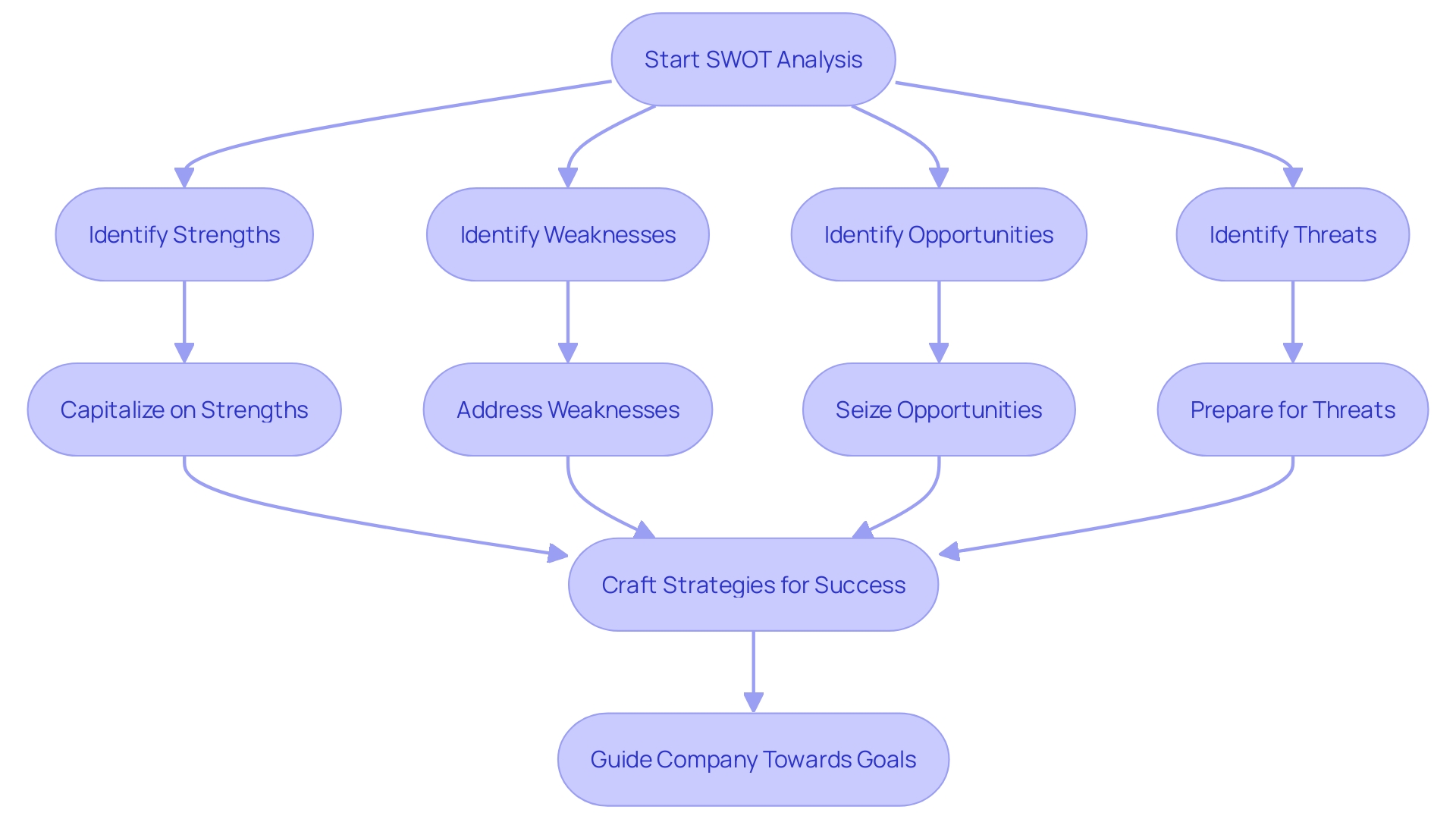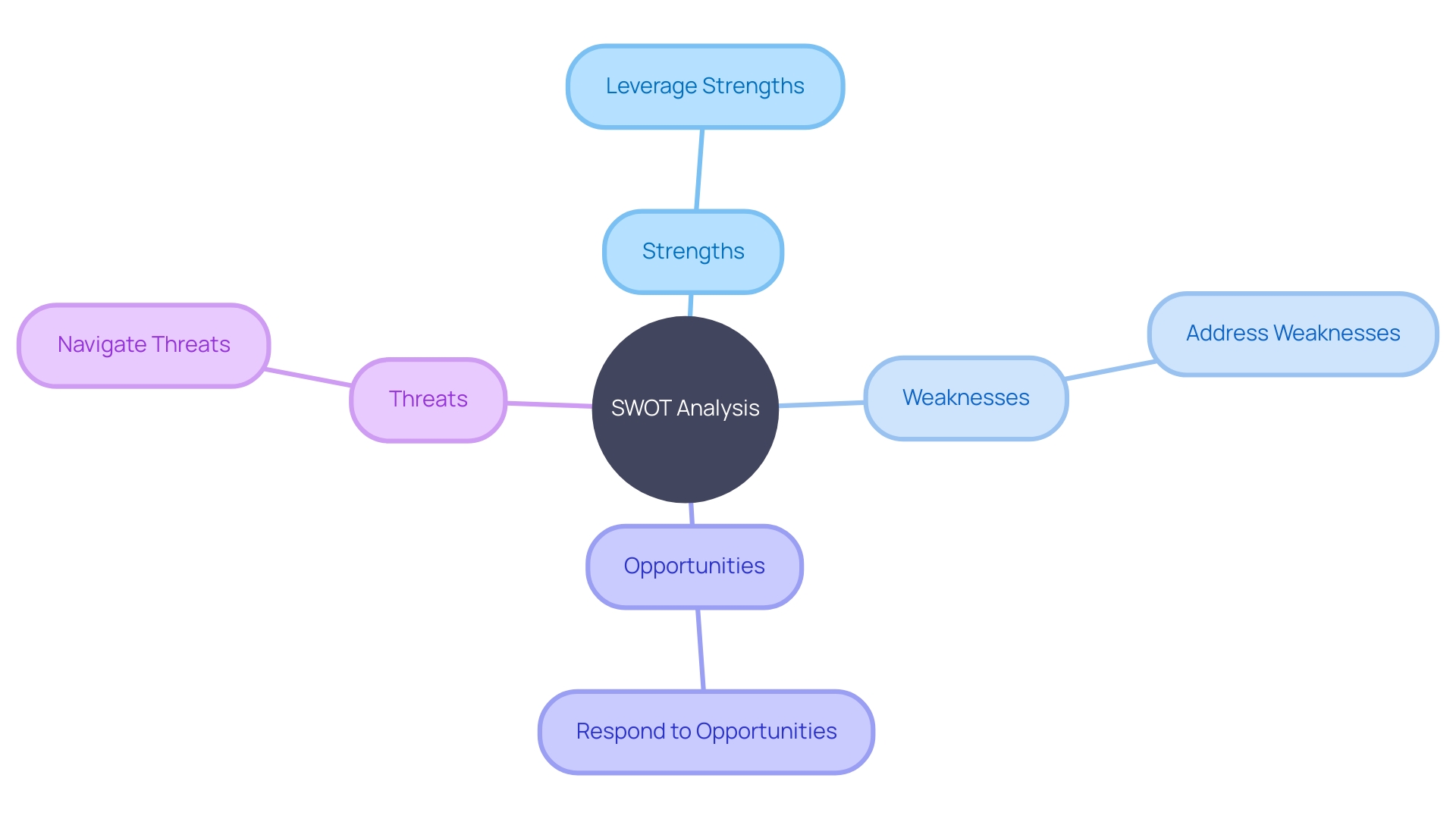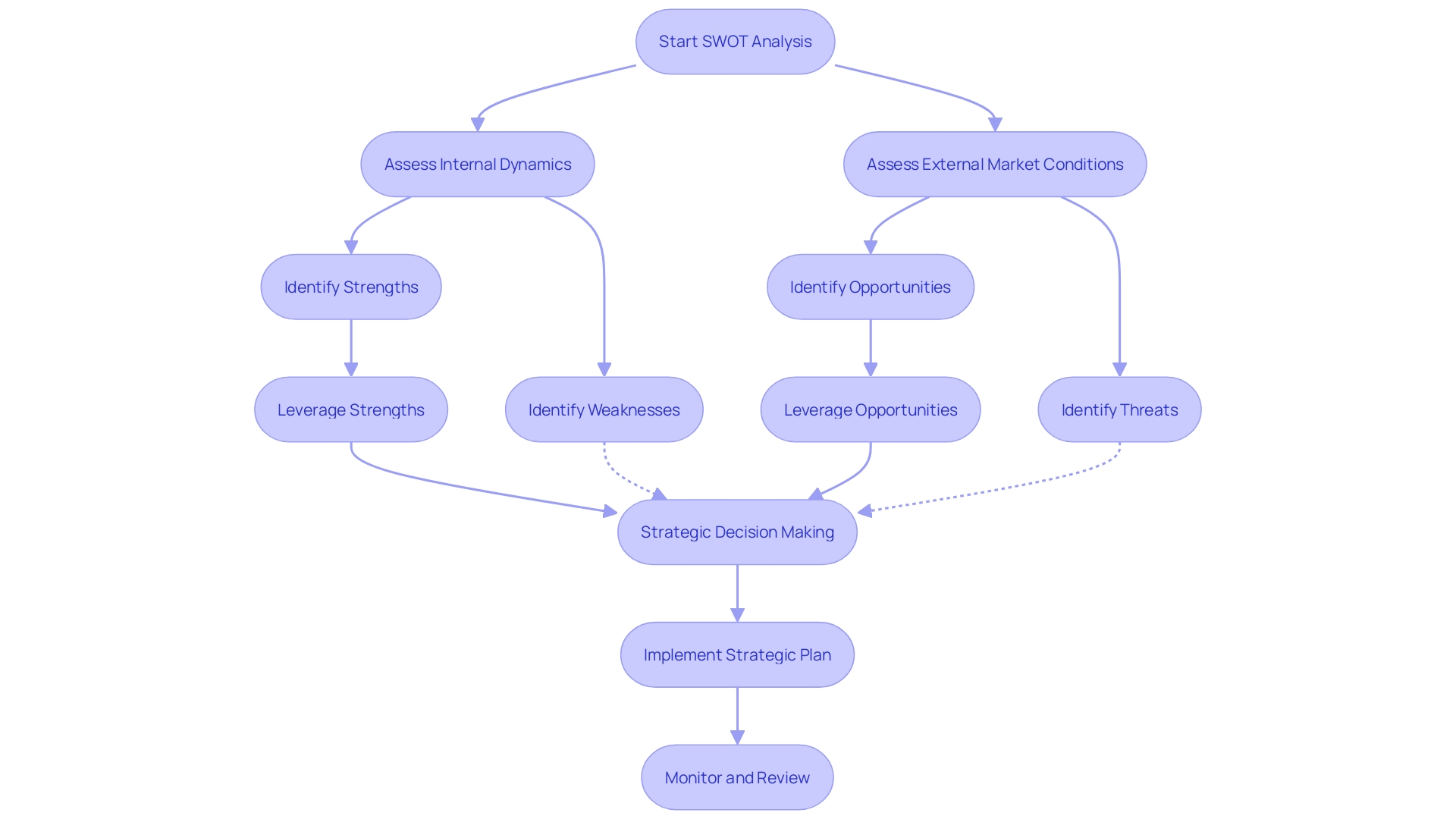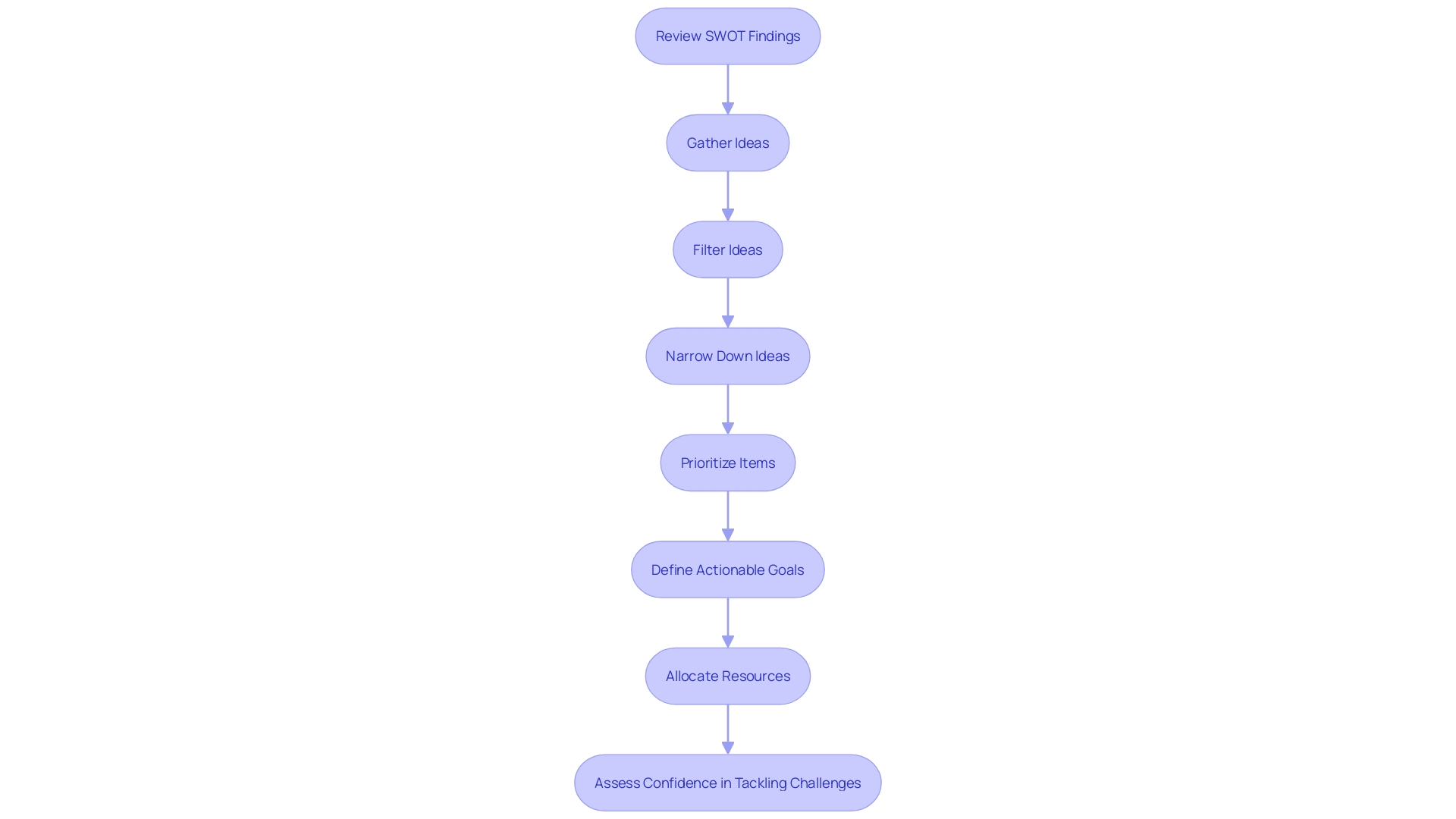Introduction
A SWOT analysis is a powerful tool that helps organizations strategically assess their position in the market. By analyzing their strengths, weaknesses, opportunities, and threats, businesses gain a comprehensive understanding of their internal operations and external environment. This article explores the importance of SWOT analysis in business strategy, provides practical steps for conducting an analysis, offers practical examples, and discusses how to act on the findings.
By following a structured approach and regularly updating the analysis, businesses can make informed decisions and set a clear course for success.
What is SWOT Analysis?
A SWOT analysis is an invaluable strategic planning tool that enables organizations to map out their unique position within an industry. This acronym represents the critical elements of the analysis: Strengths, Weaknesses, Opportunities, and Threats. By dissecting these components, businesses can gain a comprehensive understanding of their internal operations and external environment.
Strengths are the distinct advantages an organization possesses over its competitors, which could range from a skilled workforce, robust financial reserves, to cutting-edge technological assets. On the flip side, weaknesses are internal factors that may hinder a company's performance, such as limited resources or outdated systems.
For opportunities, these are external chances for a business to grow and improve its market standing, possibly through emerging market trends or policy changes. Contrarily, threats encompass external challenges that could negatively impact the business, like rising material costs or increased competition.
The essence of SWOT is not just in listing these factors but in using the analysis to strategically position the company. It's about leveraging strengths to seize opportunities while simultaneously addressing weaknesses and preparing for potential threats. The ultimate goal is to develop a strategy that not only supports the business's current state but also directs it towards future goals and success.
Through this methodical approach, a SWOT analysis is not just a snapshot of where a business stands but a roadmap for where it aims to go, ensuring decisions are informed, strategic, and aligned with the company's objectives.

Importance of SWOT Analysis in Business Strategy
A SWOT analysis, serving as a cornerstone of strategic planning, empowers businesses to dissect and leverage their internal capabilities and navigate the external business landscape effectively. It's a tool that delineates an organization's Strengths, Weaknesses, Opportunities, and Threats—providing a panoramic view of its competitive standing and potential growth trajectory. For instance, a company's strengths might shine through its innovative workforce, robust financial reserves, or cutting-edge technology, setting it apart in the market.
Meanwhile, opportunities and threats, external by nature, could range from pioneering alternative fuels to navigating economic shifts like wage increases. By harnessing SWOT, organizations can sculpt strategies that not only play to their strengths and shore up weaknesses but also respond with agility to the dynamic business environment.

How to Conduct a SWOT Analysis
Embarking on a SWOT analysis entails a structured approach to dissecting your organization's internal capabilities and external market position. This framework delineates the strengths that distinguish your business, the weaknesses that require management, the opportunities ripe for capture, and the threats that must be mitigated. Notably, strengths and weaknesses are internal facets, such as your company's robust financial health or innovative technological edge, while opportunities and threats exist in the external business environment.
By applying this analytical tool, you can craft strategic initiatives that leverage your unique advantages, address areas for improvement, and align your business trajectory with the external landscape.
For instance, the SWOT framework has been instrumental for businesses in assessing their industry standing. A clear illustration of this is the implementation of automated tools like the SWA, which streamline operational planning by utilizing advanced data from digital imagery. Such tools have slashed planning times drastically, from roughly an hour to a mere ten minutes, exemplifying how leveraging strengths—in this case, technological capabilities—can effectively address opportunities and threats in the operational landscape.
Furthermore, the Global State of Business Analysis Report underscores the significance of such analytical tools, revealing trends and demographics in the field of business analysis that are shaping organizational strategies globally. This insight is particularly valuable for crafting a SWOT analysis that is not only reflective of internal conditions but also attuned to the evolving business environment.
Ultimately, a robust SWOT analysis can serve as a compass for your business, pointing the way forward through strategic planning and informed decision-making. It's a framework that not only helps in understanding where your business currently stands but also in envisioning where it should head in the future.

Step 1: Identify Your Objective
Initiating a SWOT analysis begins with a crystal-clear objective. It’s pivotal to pinpoint the precise goal you're aiming to achieve or the exact aspect you're evaluating. This sharp focus serves as a beacon, guiding your analysis to align snugly with your particular ambitions.
Consider, for example, businesses that harness the SWOT framework; they meticulously dissect their strengths and weaknesses—internal factors like financial robustness or technological prowess—alongside external opportunities and threats. The outcomes of this rigorous analysis are not mere academic exercises. They are strategic blueprints that enable firms to wield their strengths advantageously, shore up vulnerabilities, and navigate their industry's landscape with a proactive stance.
Similarly, case studies exemplify the potency of a well-defined purpose. They plunge into complex issues, offering a holistic comprehension and showcasing analytical acumen through real-world scenarios. A case study's depth transforms it from mere narrative to a potent tool for persuasion and engagement.
The objective of your SWOT analysis should mirror this depth, serving as a structured platform that reveals the interplay of internal dynamics and external market forces, all poised to sculpt your organization’s strategic direction.

Step 2: Analyze Strengths
To pinpoint your organization's strengths, consider unique assets that offer a market edge, like NVIDIA Inception's provision of advanced technical resources and investor networking to startups at any stage. Assess your internal capabilities, looking for diversity in skills as exemplified by the engine team handling various engineering and programming challenges. Recognize your brand's influence, as Chess.com has done by fostering a massive community around the timeless game of chess.
Consider your workforce's expertise, their dedication, and the infrastructure that supports their productivity and innovation. Just as Chess.com's strategic IT investments have cultivated a global digital chess platform, your company's strengths may lie in its ability to harness technology for expansive reach and customer satisfaction.
Step 3: Analyze Weaknesses
When you're pinpointing weaknesses within your organization, you're aiming to uncover internal factors that could be impeding your performance or creating a competitive disadvantage. Common culprits of underperformance can range from insufficient resources and dated technology to a lackluster brand image. But it's not just about identifying these issues; it's about understanding their impact on your company's potential and devising strategic solutions.
-
Resource Limitations: A glaring sign of a company's weakness is often a shortfall in essential resources. This constraint can manifest as a lack of financial, human, or material capital, which hampers day-to-day operations and stifles growth potential.
-
Technology Obsolescence: In an era where British chip designing giant Arm is steering towards Nasdaq listing to leverage advancements in AI, falling behind on the technological curve can be detrimental. Outdated systems not only slow down productivity but also place you at a significant disadvantage in a tech-driven marketplace.
-
Weak Brand Perception: Brand image is an intangible yet critical asset. If your company struggles with a weak brand image, it can negatively influence customer loyalty and the ability to attract top talent, especially considering the information density and the discerning eye of recruiters in today's job market.
-
Operational Inefficiencies: Ellen Ullman's metaphor on building computers and cities resonates with the importance of a well-structured operational framework. Operational inefficiencies, much like a city built without a plan, can lead to a domino effect of performance issues across the company.
-
Analytical Approaches: A rigorous analysis, similar to a startup's ROI calculation for new ventures, should be applied to identify and measure these weaknesses. The success criteria set for identifying these areas should be comprehensive, minimal, written, and falsifiable, ensuring a clear and actionable plan for improvement.
-
Market Positioning: As per Dan Ives' observations on Arm's stock listing and the 'AI gold rush,' recognizing your market positioning and adapting to emerging trends is crucial. Failing to capitalize on such opportunities not only limits current potential but also jeopardizes future market relevance.
By taking a systematic approach to identify and address these weaknesses, your company can pivot strategically, ensuring a robust competitive stance and sustainable growth.
Step 4: Identify Opportunities
Exploring market opportunities is essential for any company aiming to thrive in today's business landscape. Opportunities often manifest as external factors, such as shifts in consumer preferences, under-served market segments, and advancements in technology. For instance, the adoption of digital transformation has become a necessity rather than a luxury in the wake of the pandemic.
Firms are investing heavily in AI, AR/VR, IoT, and other emerging technologies to preserve or enhance their business value. Statistics reveal a significant increase in investments in these areas, emphasizing the importance of seizing technological trends for business growth.
Additionally, understanding the consumer base is pivotal. Market research that includes demographic data such as age, wealth, family, and interests is invaluable. It helps ascertain the demand for a product or service and the size of the potential market.
For example, a hotel company that implemented foundational tools like Google Analytics and Conversion Tracking significantly improved their booking rates by targeting their advertising more effectively.
In the words of an investment expert, diversification in investment opportunities should be strategic, focusing on the best ideas rather than an extensive array of mediocre ones. This principle applies to market opportunities; identifying and leveraging a few well-researched opportunities can lead to better outcomes than spreading efforts too thinly. Businesses like Eli Lilly and Microsoft have demonstrated growth by investing in research and development and seizing early opportunities in AI, respectively, resulting in substantial long-term returns.
Ultimately, recognizing and capitalizing on market opportunities requires a blend of strategic planning, in-depth market research, and a willingness to invest in technological trends. These steps can create favorable conditions for a company's growth and ensure a competitive edge in the industry.
Step 5: Identify Threats
When considering the potential threats or challenges that your company may encounter, it's essential to look beyond the obvious. Take, for instance, the subtle yet significant threat of sophisticated cyber attacks. Recent incidents have highlighted that attackers are not just targeting traditional systems but are also exploiting less obvious avenues like cloud services.
A case in point involved an AWS incident where attackers sought to abuse the Simple Email Service (SES) to send out phishing emails, despite the client not using SES. This example underscores the need for vigilant monitoring and robust security protocols across all services, not just the ones in active use.
Furthermore, the landscape of economic competition is evolving with the advent of technologies such as blockchain and digital currencies. In Asia, for example, the launch of China's digital renminbi and South Korea's initiatives around blockchain and digital assets signify a shift in economic dynamics that companies must be prepared for. These developments could lead to shifts in trade policies and consumer behaviors that companies should be aware of.
Innovation in technology also presents a paradoxical threat; while it drives progress, it can also create barriers to entry. The economic system's ability to generate wealth is often at odds with maintaining free market competition, as seen in Google's hefty payments to remain the default search engine on various platforms. Such practices can prevent new entrants from gaining a foothold in the market, making it crucial for companies to stay informed and adaptable.
Ultimately, the key is to continuously evolve your company's safeguards and strategies in response to these emerging threats. By doing so, you can not only protect your company but also turn potential challenges into opportunities for growth and innovation.
Practical Examples of SWOT Analysis
Exploring the SWOT Analysis framework, we delve into two distinct instances where businesses have utilized this tool to navigate their market landscape. Firstly, we consider a company that recognized its robust financial health and cutting-edge technological infrastructure as primary strengths. These assets have not only distinguished the company within its industry but have also laid the groundwork for innovative strategies that harness these internal capabilities.
In contrast to strengths, the company also acknowledged several external threats, such as the volatility of material costs and intensifying competition, elements beyond their direct control. By identifying these threats, the organization could adopt preemptive measures, positioning itself to mitigate potential adverse effects.
Secondly, we examine a scenario where a business capitalized on opportunities presented by shifting socio-cultural and economic trends. By conducting a SWOT analysis, this company could align its growth paths, such as optimizing sales and penetrating its customer base, to enhance the customer experience and leverage market changes to its advantage.
These examples illustrate the SWOT Analysis's dual focus on internal dynamics—strengths and weaknesses—and the external environment—opportunities and threats. This comprehensive approach aids businesses in crafting informed strategies that support sustained growth and resilience in the face of challenges.
Example 1: Marketing Agency SWOT Analysis
- Strengths: An experienced marketing team and solid client relationships form the backbone of any successful agency. Notably, innovative marketing strategies set agencies apart, enabling them to harness their unique capabilities to achieve competitive advantages. - Weaknesses: Agencies often grapple with financial constraints that may limit their market reach and investment in essential resources. The absence of in-house technical expertise can hinder the delivery of comprehensive digital solutions, while high employee turnover disrupts workflow and knowledge retention. - Opportunities: A surge in demand for digital marketing services opens new avenues for growth. Agencies can potentially augment their offerings by forging strategic partnerships with businesses whose services complement their own. - Threats: The landscape is fiercely competitive, with well-established agencies vying for market share. Additionally, the rapid evolution of marketing trends and technologies demands constant adaptation, less agencies risk obsolescence.
Example 2: Ecommerce Business SWOT Analysis
-
Strengths: Boasting a diverse range of products, our e-commerce business thrives with a robust online presence and a streamlined order fulfillment system, much like Spotify which mastered user engagement through its extensive music library and user-friendly features.
-
Weaknesses: Despite our comprehensive offerings, brand recognition remains elusive, and our marketing efforts are constrained by a modest budget. Moreover, our reliance on third-party logistics mirrors the challenges faced by businesses that haven't fully integrated their supply chain solutions.
-
Opportunities: The growing inclination of consumers towards online shopping presents an opportunity to broaden our market reach or explore new product lines. This is evident from the retail systems news, where companies like S Group are innovating with electronic shelf labels to enhance their retail strategy.
-
Threats: The e-commerce landscape is fiercely competitive, with giants like Amazon setting the bar high. Additionally, the perils of cybersecurity and the unpredictability of regulatory changes loom over us, demanding vigilance and adaptive strategies.
How to Act on a SWOT Analysis
Following a comprehensive SWOT analysis, the path ahead involves not just understanding your business's strengths, weaknesses, opportunities, and threats, but translating this knowledge into actionable strategies. Let's delve into two pivotal steps to effectively harness the insights from your SWOT analysis.
Firstly, scrutinize the potential threats identified—be they regulatory shifts or emerging competitive forces—and map out proactive measures to mitigate their impact. This forward-looking approach was exemplified by Spotify, which successfully navigated the complex music industry by securing early licensing agreements with major record labels, ensuring a vast selection of tracks for its users and setting the stage for its sustained growth.
Secondly, embrace the broader perspective that a SWOT analysis affords. By engaging cross-functional teams in this strategic exercise, you foster improved communication and collaboration, creating a shared vision that is crucial for collective success. For instance, the initiatives outlined in the 2024-2026 Business Plans, such as transitioning from web content to digital services, reflect a strategic response to insights gained from such analyses.
Businesses, from startups to established enterprises, can draw from Spotify's example and the strategic foresight highlighted in recent business plans to inform their decisions, ensuring that they are not only responsive to the current market dynamics but also well-prepared for the future. By doing so, organizations can set a clear course, grounded in a comprehensive understanding of their operational environment, for sustained success and competitive advantage.
Prioritizing Items and Creating Actionable Goals
To effectively harness the insights from a SWOT Analysis, it is crucial to adopt a strategic approach. Begin with a comprehensive review of the SWOT findings, casting a wide net to gather a multitude of ideas. This initial broad phase allows for a long list of potential actions, sourced from various channels such as brainstorming sessions, expert opinions, and industry insights.
As you filter through these ideas, narrow them down using a funnel process, which refines the list to the most impactful and feasible options. This process mirrors the approach of successful companies like Spotify, which meticulously evaluates new areas to ensure they align with core capabilities and market demand.
Once you have distilled your list, prioritize the identified items by considering their potential impact and the practicality of implementation. Look to clear-cut examples in the business world, such as the routine of Tom, a CEO who asks pointed questions to uncover the biggest opportunities and necessary actions to align with strategic goals. This practice fosters a culture of focused prioritization, a lesson echoed by the principle that "When Everything is a Priority, Nothing is a Priority."
With priorities set, define actionable goals and establish specific targets. Allocate the necessary resources and strategies to emphasize your strengths, address weaknesses, harness opportunities, and neutralize threats. Employ a scoring system, perhaps on a scale from 1 to 5 or 0 to 100%, to assess the confidence in your ability to tackle potential challenges.
This systematic scoring can take into account various factors such as data availability, skillset, timeframe, organizational readiness, and the political environment, similar to the approach suggested in the project prioritization table provided by analytics experts.
In essence, align your strategic planning with real-world applications of your analysis, ensuring that every step taken is in service of the overarching goals. By doing so, you not only set a clear trajectory for success but also create a robust foundation for your organization to navigate with confidence and clarity.

Regularly Updating Your SWOT Analysis
A dynamic SWOT Analysis is crucial for an organization's continuous alignment with the ever-evolving business landscape. By actively monitoring shifts in industry trends, competitor strategies, and the company's internal environment, businesses can maintain the relevance and precision of their SWOT Analysis. This living document serves as a compass for navigating market fluctuations and seizing strategic opportunities, ensuring that the company's direction is informed by current realities and poised for future success.

Conclusion
In conclusion, a SWOT analysis is a powerful tool that helps organizations strategically assess their position in the market. By analyzing strengths, weaknesses, opportunities, and threats, businesses gain a comprehensive understanding of their internal operations and external environment. This analysis serves as a roadmap for informed decision-making and setting a clear course for success.
Conducting a SWOT analysis involves a structured approach to dissecting the organization's internal capabilities and external market position. It requires identifying clear objectives, analyzing strengths and weaknesses, identifying opportunities, and identifying potential threats. This analytical tool helps businesses craft strategies that leverage their advantages, address areas for improvement, and align their trajectory with the external landscape.
To act on the findings of a SWOT analysis, businesses must translate their knowledge into actionable strategies. This involves mapping out proactive measures to mitigate threats and engaging cross-functional teams for a broader perspective. By doing so, businesses can set a clear course for success and competitive advantage.
Prioritizing items and creating actionable goals is crucial for effectively harnessing the insights from a SWOT analysis. By narrowing down potential actions and prioritizing based on impact and feasibility, businesses can allocate resources and focus on strengths, address weaknesses, harness opportunities, and neutralize threats.
Regularly updating a SWOT analysis is essential for maintaining relevance. By monitoring industry trends, competitor strategies, and the company's internal environment, businesses can ensure their analysis serves as a compass for navigating market fluctuations and seizing opportunities.
In summary, a SWOT analysis is a valuable tool for strategic assessment. By following a structured approach, businesses can make informed decisions and set a clear course for success. It empowers organizations to leverage strengths, address weaknesses, and respond to the dynamic business environment.
Prioritizing actions and regularly updating the analysis are key to translating insights into actionable strategies. By doing so, businesses can navigate market challenges and position themselves for sustained success.




